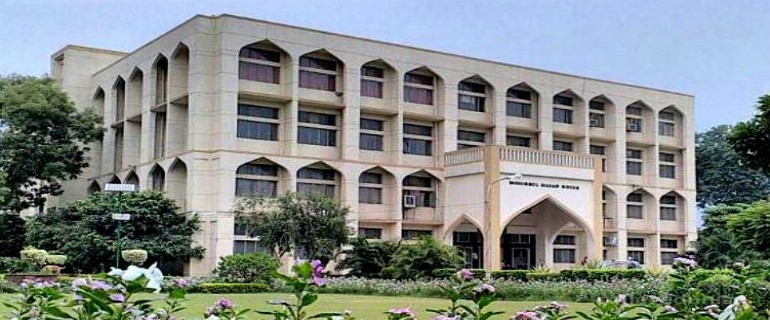| Management Courses | |
|---|---|
| B.B.A. | 3 Years |
| Bachelor of Hotel Management - BHM | 4 Years |
| Bachelor of Tourism and Travel Management | 4 Years |
| M.A. (Human Resource Management) | 2 Years |
| M.B.A. | 2 Years |
| M.B.A. (Executive) | 2 Years |
| M.Phil. (Management) | 1 Years |
| Master in Insurance Business (MIB) | 2 Years |
| M.I.B. | 2 Years |
| Ph.D. (Management Studies) | 3 Years |

Jamia Millia Islamia - JMI offers the following programs:
Why Study in Jamia Millia Islamia - JMI
Jamia Millia Islamia, an institution originally established at Aligarh in United Provinces, India in 1920 became a Central University by an act of the Indian Parliament in 1988. In Urdu language, Jamia means ‘University’, and Millia means ‘National’. The story of its growth from a small institution in the pre-independence India to a central university located in New Delhi—offering integrated education from nursery to research in specialized areas—is a saga of dedication, conviction and vision of a people who worked against all odds and saw it growing step by step. They “built up the Jamia Millia stone by stone and sacrifice by sacrifice,” said Sarojini Naidu, the nightingale of India.
Under the colonial British rule, two dominant trends joined hands and contributed towards in the birth of Jamia. One was the anti-colonial Islamic activism and the other was the pro-independence aspiration of the politically radical section of western educated Indian Muslim intelligentsia. In the political climate of 1920, the two trends gravitated together with Mahatma Gandhi as a catalyst. The anti-colonial activism signified by the Khilafat and the pro-independence aspirations symbolised by the non-cooperation movement of the Indian National Congress helped to harness creative energies and the subsequent making of Jamia Millia Islamia. Rabindranath Tagore called it “one of the most progressive educational institutions of India”.
Responding to Gandhiji’s call to boycott all educational institutions supported or run by the colonial regime, a group of nationalist teachers and students quit Aligarh Muslim University, protesting against its pro-British inclinations. The prominent members of this movement were Maulana Mehmud Hasan, Maulana Mohamed Ali, Hakim Ajmal Khan, Dr. Mukhtar Ahmad Ansari, and Abdul Majid Khwaja.
By a Special Act of the Parliament, Jamia Millia Islamia was made a central university of India in December 1988. In the list of the Faculties, i.e. Education, Humanities & Languages, Natural Sciences, Social Sciences. Engineering & Technology, one more Faculty - Faculty of Law, was added in 1989. Many new courses and programmes at UG and PG levels have since been added. Besides its Nine faculties, the Jamia has a number of centres of learning and research, like AJK-Mass Communication Research Centre (MCRC), Academy of International Studies etc. The Jamia is also marching ahead in the field of Information Technology (IT). It offers various undergraduate and postgraduate IT courses. Apart from this, the Jamia has a campus wide network which connects a large number of its departments and offices.
Right on the top is a star with the inscription“Allah O Akbar.” When in dark nights poor travellers have to traverse jungles and there is no one to show them the way, they chart their course with the help of stars. The star of Allah O Akbar is the guiding star of Jamia. Its eyes are fixed on this star which shows it the path in the darkling world. It reflects the truth that Allah is the greatest and he who bows his head before Him only, discovers the truth. Having bowed before Him, how can the head bow before anything else? Beneath this glittering star is a book with the inscription, Allammal Insaana Maalam Yalam (Taught man that which he knew not). This is the Holy Quran. Through the Holy Quran, Allah has revealed His Will to His differences of caste, class, colour; of master and slave, and became true to His tenets. This book led from darkness to light, and placed the wayward and lost on the Straight Path. The Prophet made an example of his own life. By the light of his eyes and the warmth of his heart, He prepared a group of good persons who cleaned the world of evil and spread the Word of God. On either side of the Book are two date tress typical of the land where God’s last Prophet was born. They are symbolic of the barren valley in which nothing grew; but it was there that the sapling of din took root. These trees are emblems of hope from a land in which not a leaf or flower could sprout; but wherein suddenly the springs of hidaya burst forth and drenched the “communities of the heart”.
To know more about the Admission Process call us at +91-9538317377 | +91-7411666661

Global Education Fair
Get Expert Guidance on Top institutions, Courses, Admission, Fees, Visa & Scholarships Attend the Global Education Fair & apply for scholarships & spot offers
Register Now

University Visit
Meet delegates from Top Institutions at Global Opportunities PAN India Branches. Plan your career with our experts and secure your future!
Visit us